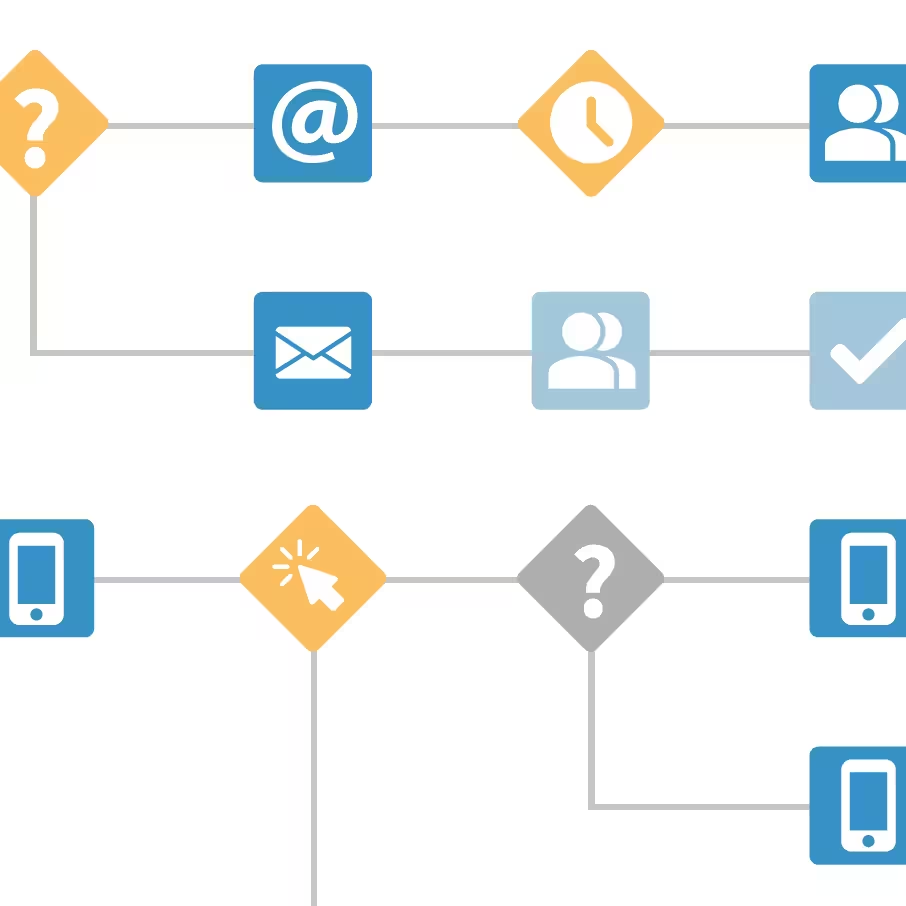Marketing automation: 13 critical mistakes when choosing a platform
Choosing the right marketing technology is always a challenge. We work with numerous customers on different marketing clouds and have supported many companies during the evaluation. In doing so, we found that many companies stumble upon avoidable mistakes when choosing a platform, which not only cost time and resources, but can also have long-term effects on marketing strategy. In this blog post, we look at the 13 most common pitfalls when choosing a marketing automation platform and give tips on how you can avoid them.

Mistake 1: Don't switch
Many companies persist too long on outdated platforms that no longer meet their needs. They have become accustomed to cumbersome manual processes and accept that certain customizations or automations are simply not possible.
This persistence means that companies outgrow their platforms but are unable to decide to switch out of habit or because of supposedly unbeatable prices.
In doing so, they are wasting enormous potential, particularly in the areas of automation, personalization and omnichannel marketing. Modern tools can get a lot more out of marketing. It is important to regularly check whether the current platform still offers all the required functions and connections and whether a change would bring benefits in the long term.
Mistake 2: Overpricing feature lists
A common mistake in tenders is relying on extensive feature lists, which are often several hundred lines long and differentiate between “must-have” and “nice-to-have.” This often involves querying the entire range of possible functions without pragmatically checking where the actual priorities lie. In most cases, all functions are classified as “must-haves.”
However, these lists rarely take into account important aspects such as usability, workflows or the internal knowledge required to operate the platforms. In addition, solutions that have completely different focal points are often compared. A tool that is strong in the email channel and has a good connection to your own shop will of course have different features than an omnichannel tool, in which the connection to the shop and CRM must first be created.
Instead, you should focus on:
- Question which features are really needed and which are secondary or not required at all in practice.
- How well does the solution fit your internal system landscape? Thoroughly check how the solution can be integrated into the existing system landscape.
- Which data must be connected and what are the interfaces? Interview relevant people from other departments, in particular the product owners of the various systems, about the requirements for interfaces.
- Take factors that are difficult to measure, such as usability, into account in all aspects. How quickly and efficiently can appropriate campaigns be set up?
Mistake 3: Make marketing software an IT topic
Make sure that marketing is in charge of the selection and that IT provides advice. When the IT department dominates platform evaluation, marketing use cases can fade into the background. This can result in choosing a solution that is technically sound but deprives the marketing team of the necessary agility and ability to act. If any expansion of the data model, evaluations or new selections must be requested via IT in the future, or if the platform can only be operated and expanded by external consultants, this must be taken into account when making the selection.
But marketing should not be viewed in isolation either, because integration into the existing system landscape is important for the success of data-driven digital marketing. Involve colleagues from other departments at an early stage to clarify integration requirements. A good connection to all systems that contain marketing-relevant data can make the difference between successful implementation and costly failure.
Mistake 4: Unclear or unrealistic expectations
Often, either too few or too many, insufficiently specified requirements are placed on the new platform. This can result in an oversized or insufficiently configured solution. To avoid this:
- Create an overview of all systems that should exchange data with your marketing system.
- Determine which data you need for your customer journeys and campaigns: What data do you need to get started? What data is required for medium and long-term campaigns?
- Where should data processing, aggregation, transformation and scoring take place — in the marketing system or in upstream systems?
- Analyze your team's existing resources and technical capabilities. Identify specific training needs for different team members to operate a new system and realistically plan resources for implementation and ongoing operations.
- Define a feasible and manageable implementation project, a “minimum viable setup.”
Mistake 5: Superficial definition of use cases
Many companies define their use cases too superficially (“we want to send personalized newsletters”). They are dazzled by the manufacturers' platform demos, which convey that the tool easily covers all possible requirements. But: What you see there rarely corresponds to the subsequent implementation reality in your company. The demos are based on ideal test data, which is already perfectly prepared and structured. Personalization variables from various data sources are fully implemented, product data is available in optimal form and all data tables are already correctly linked.
Instead, it is advisable to define specific use cases tailored to your own company with your own sample data, which are shown in the platform demo. Let the manufacturer or partner show you how easy or complex it is to cover your specific use cases.
Ask critical questions in the demo: Many of the processes shown are not available as standard, but require extensive adjustments and development work. For non-typical use cases, it may be useful to carry out a proof of concept with the top 2-3 platforms, possibly with the support of a partner.
Also think long-term: Define which use cases you want to implement in the short, medium and long term and consider how the requirements could develop in the future. Which channels should be operated and controlled in the future and which systems should be connected in the future?
Mistake 6: Blind trust in big providers
It is a common misconception that the solutions from major enterprise providers such as SAP, Salesforce, Adobe and Oracle are automatically the best choice. Many companies assume that their multi-cloud solutions offer “everything from a single source” and reduce integration costs. What the sales department of major providers often conceals: The individual solutions are often not well integrated, as they were purchased and subsequently expanded.
In practice, even large providers require considerable integration efforts to effectively connect different systems with each other. In addition, large providers like to sell their marketing solutions when a CRM or shop solution is purchased — but that does not automatically mean that the systems communicate well with each other and are integrated with each other out of the box.
In addition to the size and stability of a provider, other factors should also be considered when choosing: How widespread is the solution? How satisfied are customers? What is the provider's current and future roadmap? Is the tool constantly being developed? Is the manufacturer working on the topics that are important to you? And what capacity does he have to implement innovations?
Mistake 7: Looking uncritically at reference customers
Reference customers who are recommended by providers often convey a better picture. Let the reference customers tell you in detail how the implementation went and how long it took to implement the first use cases.
You can also use your own network or ask agency partners who else has experience with a particular platform and how work is assessed in everyday life. Get detailed information about the duration of implementation and the challenges of day-to-day operations. This first-hand information can give you a more realistic picture of the platform and its practicality.
Mistake 8: Overestimating vendor flexibility
Don't rely on the manufacturers' blanket statement that functions or integrations that do not yet exist can be delivered at a later stage. In reality, many platform providers are unwilling or unable to meet specific individual requirements. Clarify in advance whether you need a provider who can meet individual integration requirements. Find out specifically whether providers carry out individual developments for you or refer you to partners if you need something that is not available out of the box.
Many manufacturers make a general promise: “Integration with System X is available.” Review the details of the existing integrations: What exactly do they look like? Which data is compared? Is the data exchange mono-directional or bidirectional? Which triggers are available for marketing?
Also note that if the systems can be connected via integration-as-a-service middleware tools or customer-developed middleware tools, this must be taken into account in tool costs and may have an impact on the migration schedule and testing effort.
An important factor is also whether, after implementation, the solution can be operated in daily operation without manufacturer support or in-house or external developers, in particular for selections and data-driven processes.
Mistake 9: Neglecting API functionality
The API functionality is often narrowly discussed when tendering, but is crucial for the effective use of a marketing automation platform. Your digital marketing needs data, and if you want to control data processes via the API, it's important to review this thoroughly.
It is advisable to work closely with your IT department or system integrator to analyze the manufacturer's API documentation and price list for limits and quotas. High additional costs can be hidden here! Review the functionality of the API and the associated costs. Clarify how the data can be fed into the system and read out again.
Mistake 10: Unclear responsibilities
One frequently overlooked organizational mistake is the lack of clear responsibilities for the marketing system. This can lead to inefficiencies and communication issues that jeopardize the successful implementation and use of the platform.
Identify an “owner” within the marketing department who is responsible for the system. Define exactly who operates the system and who — in collaboration with other departments — defines the use cases. There should be a central person who coordinates which systems are connected and which data must be available in the marketing platform.
Even during ongoing operations, this responsible person should keep track of which employees have completed which training courses, what skill level they have and which additional competencies must be covered internally or externally.
Mistake 11: Pay for everything from the start
Many companies pay for an oversized platform with unused features in the first few months or even the first year. Be careful with tempting package prices and discounts from providers. Even the best package price is too expensive in the long term if you don't use the features. When signing a contract, it is better to negotiate a cheap, phased upgrade plan than a large package right from the start.
Consider how quickly you can actually implement various customer journeys and channels and what priorities you should set. Develop a step-by-step plan that determines which modules make sense in which phase and initially license only what you will realistically use. In order to make realistic assumptions about the quantitative use of the platform, it is advisable to seek advice from experienced agencies or talk to other companies that have already introduced the tool. Inquire about the effort involved in introducing individual modules or implementing specific use cases.
Also critically review the manufacturers' offers: Are the volumes included realistic? The quotas are often set too high and are only partially exhausted. On the other hand, quotas that are set too low can result in high overdraft fees if you exceed the limits.
Take into account not only start-up costs, but also follow-up costs. Can you set up all other use cases and journeys with your own team? What about new target groups, selections, reports and optimizations? Do you need permanent external support? A thorough analysis of these aspects helps you make a cost-effective and sustainable decision.
Mistake 12: Good tool with poor service
When choosing a marketing automation platform, the focus is often on functionality and license price. It is easy to overlook the fact that the success of a platform depends largely on the quality of the accompanying services. It is therefore important to take a close look at the provider's partner ecosystem.
Learn about the implementation and agency partners available. While many manufacturers support their customers in the implementation phase, it is important to know whether competent success managers and marketing consultants are available even after setup. Long-term support is often just as important as initial setup.
Before concluding the contract, think about the post-implementation support concept. What response times are guaranteed? How are the costs for consulting and technical support structured? This information can be critical when it comes to using the platform effectively and resolving issues that arise quickly.
Also consider the availability of training and continuing education opportunities for your team. A good provider should not only provide a powerful platform, but also ensure that your employees can make optimal use of it. In the end, excellent service can make the difference between mediocre and excellent implementation. It can help you use the platform faster and more efficiently, avoid problems, and get the most out of your investment over the long term.
Mistake 13: Book expensive support and consulting packages
While good service is important, you should beware of expensive support and consulting packages that are often offered by manufacturers. It's important to understand that general manufacturer support is often unfamiliar with the specific details of your individual setup and business. This may mean that they are unable to respond to problems as effectively as a specialist partner could.
Instead, it often makes more sense to negotiate with an experienced partner who knows your individual setup and has marketing experience in your industry. Such partners can offer tailored support quotas and individual service level agreements (SLAs) that are tailored exactly to your needs.
A specialized partner has the advantage that they not only know the platform in general, but are also familiar with the specific adjustments and integrations that have been made for your company. As a result, he can react faster and more specifically to problems and proactively suggest improvements.
Before you choose a support package, you should carefully consider what type of assistance you actually need. Often, a mix of in-house expertise, targeted external assistance, and measured manufacturer support can be the most cost-effective and efficient solution.
Choosing the right marketing automation platform is a complex task that requires many factors to be considered. By avoiding these 13 common mistakes, you'll increase your chances of finding a solution that really suits you and moves your marketing forward. Remember that choosing a platform is just the first step. In the next blog post, we'll look at the pitfalls that can lurk when setting up a digital marketing solution.














